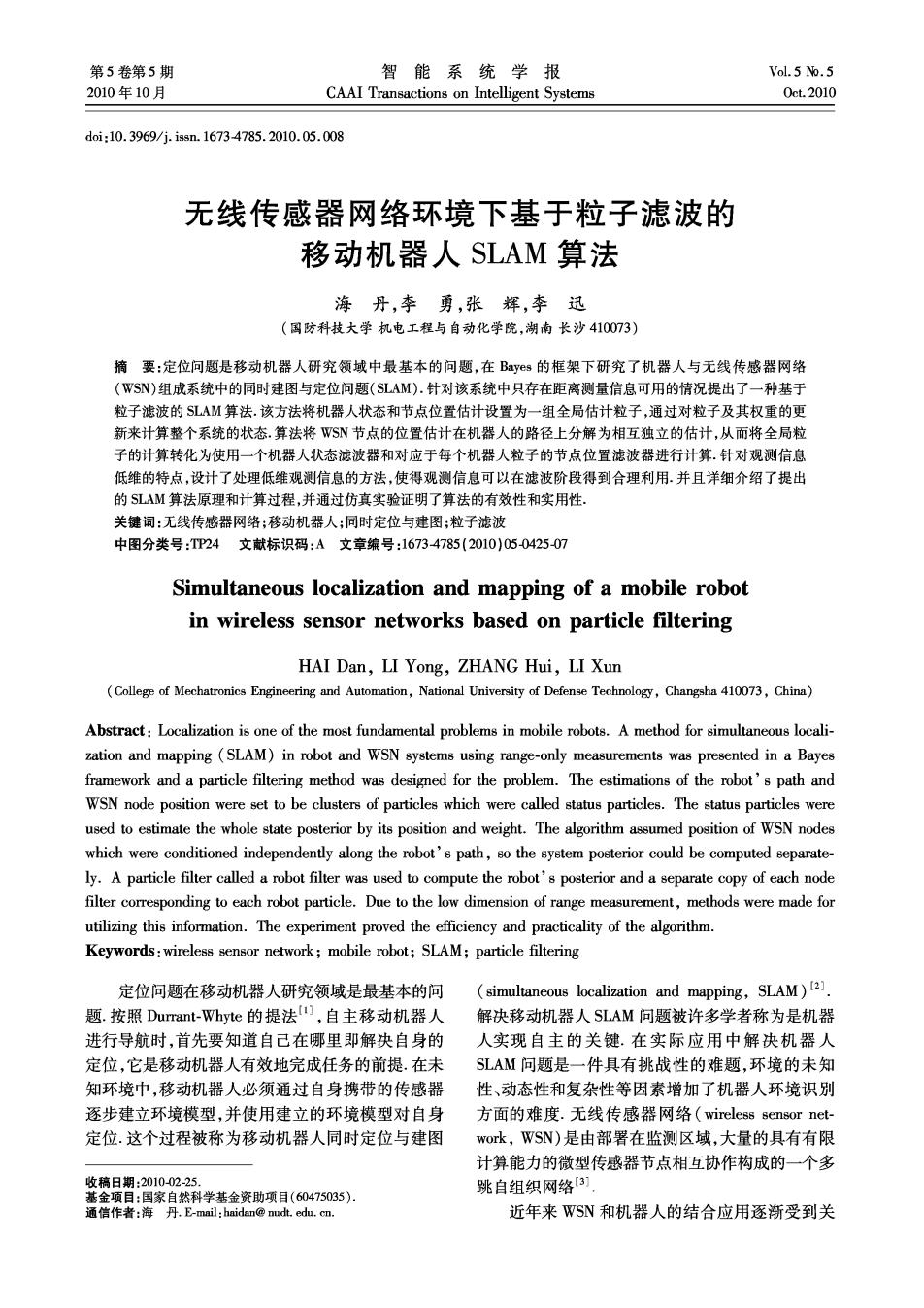正在加载图片...

第5卷第5期 智能系统学报 Vol.5 No.5 2010年10月 CAAI Transactions on Intelligent Systems 0ct.2010 doi:10.3969/i.issn.1673-4785.2010.05.008 无线传感器网络环境下基于粒子滤波的 移动机器人SLAM算法 海丹,李勇,张辉,李迅 (国防科技大学机电工程与自动化学院,湖南长沙410073) 摘要:定位问题是移动机器人研究领域中最基本的问题,在Bayes的框架下研究了机器人与无线传感器网络 (WSN)组成系统中的同时建图与定位问题(SLAM).针对该系统中只存在距离测量信息可用的情况提出了一种基于 粒子滤波的SLAM算法.该方法将机器人状态和节点位置估计设置为一组全局估计粒子,通过对粒子及其权重的更 新来计算整个系统的状态.算法将WSN节点的位置估计在机器人的路径上分解为相互独立的估计,从而将全局粒 子的计算转化为使用一个机器人状态滤波器和对应于每个机器人粒子的节点位置滤波器进行计算.针对观测信息 低维的特点,设计了处理低维观测信息的方法,使得观测信息可以在滤波阶段得到合理利用.并且详细介绍了提出 的SLAM算法原理和计算过程,并通过仿真实验证明了算法的有效性和实用性. 关键词:无线传感器网络;移动机器人;同时定位与建图;粒子滤波 中图分类号:TP24文献标识码:A文章编号:16734785(2010)05042507 Simultaneous localization and mapping of a mobile robot in wireless sensor networks based on particle filtering HAI Dan,LI Yong,ZHANG Hui,LI Xun College of Mechatronics Engineering and Automation,National University of Defense Technology,Changsha 410073,China) Abstract:Localization is one of the most fundamental problems in mobile robots.A method for simultaneous locali- zation and mapping (SLAM)in robot and WSN systems using range-only measurements was presented in a Bayes framework and a particle filtering method was designed for the problem.The estimations of the robot's path and WSN node position were set to be clusters of particles which were called status particles.The status particles were used to estimate the whole state posterior by its position and weight.The algorithm assumed position of WSN nodes which were conditioned independently along the robot's path,so the system posterior could be computed separate- ly.A particle filter called a robot filter was used to compute the robot's posterior and a separate copy of each node filter corresponding to each robot particle.Due to the low dimension of range measurement,methods were made for utilizing this information.The experiment proved the efficiency and practicality of the algorithm. Keywords:wireless sensor network;mobile robot;SLAM;particle filtering 定位问题在移动机器人研究领域是最基本的问 (simultaneous localization and mapping,SLAM)(2 题.按照Durrant-Whyte的提法I,自主移动机器人解决移动机器人SLAM问题被许多学者称为是机器 进行导航时,首先要知道自己在哪里即解决自身的 人实现自主的关键.在实际应用中解决机器人 定位,它是移动机器人有效地完成任务的前提.在未 SLAM问题是一件具有挑战性的难题,环境的未知 知环境中,移动机器人必须通过自身携带的传感器 性、动态性和复杂性等因素增加了机器人环境识别 逐步建立环境模型,并使用建立的环境模型对自身 方面的难度.无线传感器网络(wireless sensor net- 定位.这个过程被称为移动机器人同时定位与建图 wok,WSN)是由部署在监测区域,大量的具有有限 计算能力的微型传感器节点相互协作构成的一个多 收稿日期:2010-02-25. 跳自组织网络「3) 基金项目:国家自然科学基金资助项目(60475035) 通信作者:海丹.E-mail:haidan@udt.edu.cm. 近年来WSN和机器人的结合应用逐渐受到关